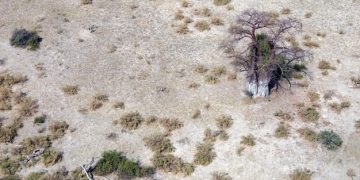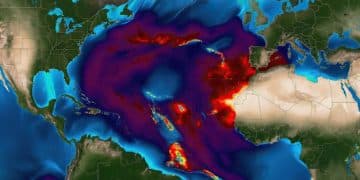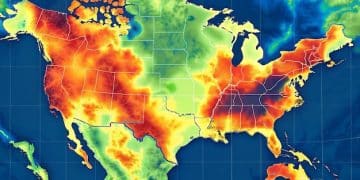Projected Impacts of Climate Change on US Agriculture & Food Security by 2040
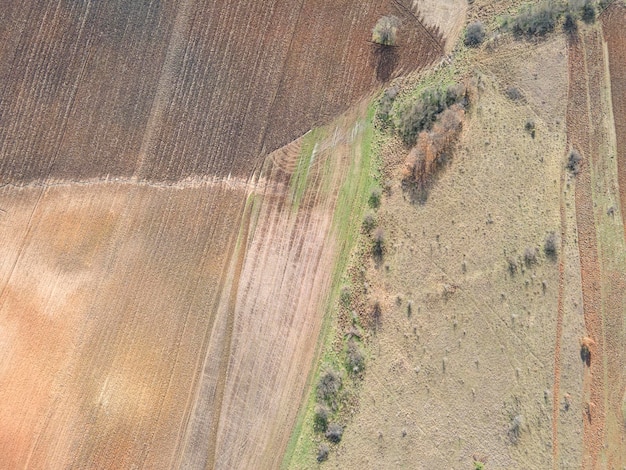
By 2040, climate change is projected to significantly alter US agriculture through increased extreme weather, shifting growing seasons, and water scarcity, potentially impacting national food security and necessitating widespread adaptive measures across the agricultural sector.
Understanding what the projected impacts of climate change on US agriculture and food security by 2040 are is no longer a distant theoretical exercise; it is an urgent assessment of an evolving reality. The agricultural landscapes and food systems that underpin the United States are uniquely vulnerable to the accelerating pace of climate shifts.
The Shifting Climate Landscape and Its Agricultural Imperatives
The United States, with its diverse agricultural regions, faces a complex array of climatic changes that will profoundly reshape its farming practices and food production by 2040. These shifts are not merely incremental; they represent fundamental alterations to temperature regimes, precipitation patterns, and the frequency of extreme weather events. Farmers, policymakers, and consumers alike are grappling with how these transformations will challenge traditional methods and demand innovative solutions. The imperative is clear: adapt or face significant disruptions to a cornerstone of the nation’s economy and well-being.
The concept of a stable climate, once a foundation for agricultural planning, is increasingly untenable. Rising average temperatures mean longer growing seasons in some northern regions, but also increased heat stress in traditionally productive areas, threatening crop yields and livestock health. Simultaneously, shifts in precipitation are creating a dichotomy: more intense rainfall leading to flooding and soil erosion in some areas, while prolonged droughts intensify in others, particularly the arid and semi-arid west. This unpredictability complicates every aspect of farming, from planting schedules to irrigation needs.
Altered Growing Seasons and Crop Viability
One of the most direct impacts of rising temperatures is the alteration of growing seasons. In some northern states, this could mean an extension of planting windows, potentially allowing for new crops or additional harvests. However, this advantage is often offset by increased pest pressure and the challenge of managing new disease vectors that thrive in warmer conditions. In the heartland and southern states, higher temperatures can push crops beyond their optimal growth thresholds, leading to reduced yields and quality.
Consider maize, a staple of US agriculture. Elevated night-time temperatures during critical growth stages can significantly hinder its development. Similarly, heat stress can reduce the protein content in wheat and diminish the size and quality of fruits. The delicate balance required for optimal photosynthesis and nutrient uptake is easily disrupted, leading to potential economic losses and reduced nutritional output.
- Shifting phenology: Plants flowering or fruiting earlier.
- Increased heat stress days: More days exceeding critical temperature thresholds for crops.
- New pest and disease ranges: Warmer winters allow pests to survive and spread further.
- Reduced chilling hours: Impacting fruit and nut trees that require specific cold periods.
Water Scarcity and Management Challenges
The availability of water is perhaps the most critical factor for agriculture, and climate change is intensifying water scarcity in key agricultural regions. Snowpack in the western US, a vital natural reservoir, is diminishing, leading to reduced river flows in spring and summer. Groundwater reserves, already over-exploited in many areas, are being depleted at an unsustainable rate. This exacerbates competition for water among agriculture, urban populations, and ecosystems.
By 2040, many agricultural regions are projected to face chronic water deficits, forcing farmers to either reduce irrigated acreage, switch to less water-intensive crops, or adopt highly efficient irrigation technologies. The costs associated with securing and delivering water will undoubtedly rise, further straining agricultural economics. This challenge extends beyond irrigation, affecting livestock, which requires consistent access to clean water for hydration and cooling.
The implications for crop insurance and disaster relief are also significant. Governments and agricultural lenders will need to reassess risk profiles as weather patterns become more volatile. Financial institutions are already beginning to factor climate risk into lending decisions, which could impact farmers’ access to capital for adaptation measures. Ultimately, the cumulative effect of these climatic shifts points towards a profound transformation of how and where food is grown across the US.
Extreme Weather Events: A New Normal for Agriculture
The increasing frequency and intensity of extreme weather events pose perhaps the most immediate and visible threat to US agriculture. From devastating droughts and prolonged heatwaves to destructive floods and more powerful storms, these events canwipe out entire harvests, decimate livestock, and cause extensive damage to infrastructure. By 2040, such occurrences are projected to be not isolated incidents, but an entrenched feature of the agricultural calendar, challenging farmers’ resilience and demanding unprecedented levels of adaptation.
The sheer unpredictability of these events creates immense operational hurdles. A farmer might plant a crop based on historical weather patterns, only to see it destroyed by an unexpected deluge or prolonged dry spell. This volatility makes long-term planning incredibly difficult and increases the financial risk associated with farming, potentially pushing smaller, less diversified operations to the brink. The ripple effects extend beyond the farm gate, impacting supply chains, processing facilities, and ultimately, food prices and availability for consumers.
Droughts and Heatwaves: The Aridification Threat
Droughts, already a persistent problem in the western and parts of the central US, are set to become more severe, frequent, and prolonged. Higher temperatures accelerate evaporation, increasing the “thirst” of the atmosphere and crops. This leads to magnified water stress, even in areas that receive sufficient annual rainfall, if that rainfall is not distributed effectively. The combination of reduced precipitation and increased evaporative demand creates a vicious cycle of aridification.
Heatwaves, often accompanying droughts, directly impact crop physiology. Extreme heat during pollination, for example, can render many grain crops sterile, drastically reducing yields. Livestock are also highly vulnerable; heat stress can decrease milk production in dairy cattle, slow weight gain in beef cattle and hogs, and even lead to fatalities. Managing heat stress for animals requires significant investment in cooling systems, shade structures, and altered feeding schedules, adding to the operational burden.
Floods and Increased Precipitation Intensity
While some regions face drought, others are contending with the opposite extreme: an increase in the intensity of rainfall events. Warmer air holds more moisture, leading to “rain бомбы” – short, intense downpours that can cause flash floods. These events lead to direct crop damage, soil erosion, and nutrient runoff, washing away valuable topsoil and polluting waterways. Saturated soils can also lead to extended periods where farm machinery cannot operate, delaying planting or harvesting and affecting yield.
The heightened risk of flooding also affects agricultural infrastructure like barns, silos, and irrigation systems, leading to substantial repair or replacement costs. Moreover, persistent wet conditions can create an ideal environment for fungal diseases and root rot in crops, further diminishing yields and quality. The paradox of “Too much water, too little water” within the same growing season presents a formidable challenge for water management.

The cumulative effect of these extreme weather events is a significant increase in risk and uncertainty for the agricultural sector. Farmers are forced to balance the need for short-term disaster recovery with the long-term imperative of building resilience. This necessitates a proactive approach, including investing in resistant crop varieties, improving drainage systems, and adopting precision agriculture techniques that can optimize resource use even under fluctuating conditions. Without comprehensive strategies, the viability of certain agricultural regions could be severely compromised by 2040.
Impacts on Crop and Livestock Productivity
The projected environmental shifts by 2040 will not only batter agricultural systems with extreme weather but also subtly, yet fundamentally, alter the biological conditions essential for healthy crop and livestock productivity. These changes extend beyond immediate disaster response, touching upon the very genetic and physiological underpinnings of plant and animal life. Understanding these nuanced impacts is crucial for developing robust adaptive strategies that ensure the continued vitality of US food production.
Crop yields are a direct function of suitable growing conditions, including optimal temperatures, adequate moisture, and nutrient availability. Climate change disrupts this delicate balance. While carbon dioxide enrichment can initially boost photosynthesis for some C3 crops like wheat and rice, the benefits are often offset by higher temperatures, increased water stress, and altered nutrient cycling. The quality of produce can also suffer, with changes in protein, vitamin, and mineral content potentially impacting nutritional security.
Yield Reductions and Nutritional Quality Decline
Numerous studies indicate that many staple crops like corn, soybeans, and wheat will experience significant yield declines in key US producing regions under projected warming scenarios. This is due to a confluence of factors: thermal stress affecting critical growth stages, more frequent droughts stressing plants, and increased pest and disease pressure. Even if yields are maintained in some areas, the nutritional density of crops may diminish. For instance, higher CO2 levels can reduce the concentration of essential micronutrients like iron and zinc in grains.
This decline in nutritional quality, often termed “hidden hunger,” represents a subtle yet profound threat to food security. If staple crops become less nutritious, it could exacerbate dietary deficiencies, particularly among vulnerable populations who rely heavily on these crops for sustenance. This necessitates a focus not just on caloric output, but on nutrient-rich food production.
Livestock Health and Management Challenges
Livestock, too, faces formidable challenges. Extreme heat directly contributes to heat stress in animals, leading to reduced feed intake, lower growth rates, decreased fertility, and increased susceptibility to disease. This impacts milk production in dairy cows, egg production in poultry, and meat yields in cattle and hogs. Farmers must invest in cooling systems, improved ventilation, and altered feeding schedules to mitigate these effects, adding significant operational costs.
Beyond direct heat stress, climate change can influence the availability and quality of feed and forage. Droughts reduce pastureland productivity, forcing farmers to purchase supplemental feed, driving up costs. The changing distribution of vector-borne diseases, like those carried by ticks and mosquitoes, also poses new health risks to livestock, requiring enhanced veterinary care and disease prevention strategies.
Increased Pressure from Pests, Weeds, and Diseases
Warmer temperatures and altered precipitation patterns create more favorable conditions for the proliferation and geographic expansion of agricultural pests, weeds, and pathogens. Mild winters allow pest populations to survive and reproduce more effectively, extending their active seasons. Weeds can become more competitive, and new strains of plant diseases may emerge or spread into areas where they were previously uncommon, requiring more intensive management and potentially increased pesticide use.
This increased biological pressure not only threatens yields but also drives up production costs for farmers through higher expenditures on pest and disease control. It also presents a challenge for integrated pest management strategies, as the predictable cycles of many pests are disrupted. Vigilance and rapid adaptation to new threats will be paramount for maintaining crop and livestock health.
Disruptions to the Agricultural Supply Chain and Economy
The impacts of climate change on US agriculture extend far beyond the farm field, rippling through the entire agricultural supply chain and a significant portion of the national economy. By 2040, these disruptions are poised to reshape commodity markets, alter trade patterns, and impose considerable financial burdens on farmers, related industries, and ultimately, consumers. The interconnectedness of the food system means that vulnerabilities in one segment can cascade, affecting availability, affordability, and the strategic stability of the American food supply.
The very infrastructure that moves food from farm to fork—roads, railways, storage facilities, and processing plants—is vulnerable to extreme weather events. Floods can submerge processing plants or wash out transportation routes, halting operations or delaying deliveries. Droughts can reduce river navigation levels, impacting barge transport of bulk commodities. These infrastructure failures create bottlenecks, lead to spoilage, and increase transportation costs, all of which contribute to higher prices for consumers.
Market Volatility and Price Increases
Reduced yields or crop failures due to climate events directly translate into diminished supply. When supply dwindles, prices typically rise, leading to increased food costs for consumers. This price volatility can be particularly challenging for low-income households, exacerbating food insecurity. Furthermore, sudden shifts in commodity prices can create uncertainty for farmers, making it difficult to plan for future seasons or secure financing.
Global markets are also affected. As US agricultural output faces challenges, other food-exporting nations may also experience their own climate impacts, leading to broader global price spikes and increased competition for essential commodities. This interconnectedness means that no nation is entirely immune to the collective impacts on food systems.
Economic Dislocation for Farming Communities
The financial strain on farming communities will be immense. Loss of crops and livestock, coupled with increased operating costs for water, energy, and pest control, can lead to severe economic hardship. Crop insurance programs, while providing a safety net, are becoming increasingly expensive and may not fully cover losses, especially for novel or consecutive extreme events. Many family farms, already operating on thin margins, may find it harder to remain viable.
This economic dislocation can lead to shifts in rural demographics, with fewer young people pursuing farming and a consolidation of agricultural land under larger, more resilient operations. It also impacts local economies that depend on agricultural activity, from equipment suppliers to food processing facilities. The social fabric of rural America, deeply tied to its agricultural roots, will be tested.
Supply Chain Vulnerabilities and Resilience
The modern agricultural supply chain is highly optimized for efficiency but often at the cost of resilience. Long, complex chains involving multiple steps and modes of transport are more susceptible to disruption. A single major climate event—such as a hurricane impacting a port or a prolonged drought affecting a major grain-producing region—can create cascading failures across the entire system.
Building resilience requires diversifying supply sources, decentralizing processing facilities where feasible, and investing in climate-resilient infrastructure. Technologies like improved cold storage and more efficient transportation networks can also play a role. However, these investments are substantial and require coordinated efforts across public and private sectors to reduce the systemic risks embedded within the current food system.
Adaptive Strategies and Innovative Solutions
Addressing the multi-faceted challenges posed by climate change to US agriculture by 2040 demands a comprehensive suite of adaptive strategies and innovative solutions. These approaches must span from individual farm-level adjustments to broader systemic changes, integrating cutting-edge technology with traditional ecological wisdom. The goal is not merely to mitigate negative impacts but to build a more resilient, sustainable, and productive agricultural sector capable of thriving in a changing climate.
Adaptation is an ongoing process, requiring continuous learning and flexibility. Farmers are often at the forefront of innovation, experimenting with new practices that conserve resources and withstand variable conditions. However, the scale of the climate challenge necessitates greater support from research institutions, government agencies, and the private sector to accelerate the development and adoption of effective solutions across diverse agricultural landscapes.
Precision Agriculture and Resource Efficiency
Precision agriculture harnesses data and technology to optimize resource use, reducing waste and enhancing productivity. This includes GPS-guided machinery, variable-rate fertilizer application, and sensor-based irrigation systems that deliver water only when and where it’s needed. These tools can significantly improve water use efficiency, a critical adaptation in water-stressed regions, and optimize nutrient application, reducing runoff and environmental impact.
Moreover, the use of remote sensing and climate forecasting allows farmers to make more informed decisions about planting times, crop varieties, and pest management, proactively responding to changing conditions rather than reactively. The integration of artificial intelligence and machine learning can further enhance these capabilities, processing vast amounts of data to provide highly localized and precise recommendations.
- Smart irrigation systems: Minimizing water waste through targeted application.
- Variable-rate technology: Applying inputs precisely where needed, reducing overuse.
- Climate forecasting tools: Informing planting and harvest decisions.
- Sensor-based monitoring: Real-time data on soil moisture, nutrient levels, and plant health.
Development of Climate-Resilient Crops and Livestock
Breeding and genetic modification play a crucial role in developing crop varieties and livestock breeds that are better adapted to new climatic realities. This includes developing drought-tolerant crops, heat-resistant livestock, and varieties that can mature faster or are more resistant to emerging pests and diseases. Research into specialty crops that require less water or can tolerate higher salinity levels also offers promise for diversifying agricultural output in vulnerable regions.
For livestock, selection for heat tolerance and disease resistance can improve animal welfare and productivity under stress. Advances in animal nutrition can also help animals cope with warmer conditions. These biological adaptations represent a crucial long-term strategy for maintaining productivity under climate change.
Sustainable Land Management and Regenerative Practices
Practices that enhance soil health and ecosystem resilience are fundamental to climate adaptation. Regenerative agriculture, which emphasizes practices like no-till farming, cover cropping, and diversified crop rotations, improves soil organic matter, increasing water retention capacity and reducing erosion. Healthy soils are more resilient to both drought and intense rainfall, providing a natural buffer against extreme weather.
Agroforestry, the integration of trees and shrubs into agricultural landscapes, also offers multiple benefits, including shade for livestock, windbreaks for crops, and enhanced biodiversity. These practices not only build resilience but also sequester carbon, contributing to climate change mitigation efforts. The adoption of such holistic approaches can transform landscapes into more robust and adaptive food-producing systems.
Policy Frameworks and Economic Incentives
Effective adaptation of US agriculture to climate change by 2040 cannot rely solely on individual farm-level efforts; it requires robust policy frameworks and strategically designed economic incentives. Governmental support, both federal and state, is crucial for fostering widespread adoption of resilient practices, investing in research, and building the necessary infrastructure to safeguard food security. Without coherent policy, the agricultural sector risks fragmented responses and uneven adaptation across the nation.
These policies must be multi-pronged, addressing not only the direct impacts on farmers but also the broader economic and social ramifications. They need to balance financial viability with environmental stewardship, creating a framework where sustainable practices are adequately incentivized and market failures are addressed. This involves a collaborative approach between legislative bodies, agricultural agencies, and scientific institutions.
Federal and State Support for Adaptation
Federal programs, such as those administered by the USDA (United States Department of Agriculture), play a critical role in providing financial and technical assistance to farmers. This includes cost-share programs for conservation practices, grants for climate-resilient research, and enhanced crop insurance options that reflect new climate realities. Expanding access to these programs and ensuring they are tailored to regional climate risks will be vital.
State-level initiatives are equally important, as they can respond more directly to localized challenges. States can develop specific water management plans, promote regional crop diversification strategies, and invest in local processing and distribution networks to shorten supply chains and enhance resilience against disruptions. Coordination between federal and state efforts ensures a more comprehensive and effective response.
Incentivizing Climate-Smart Agriculture
Economic incentives are powerful drivers for change. Policies that reward farmers for adopting “climate-smart” practices—such as carbon sequestration, reduced greenhouse gas emissions, and improved water-use efficiency—can accelerate the transition to more sustainable systems. This could include direct payments, tax credits, or preferential access to markets that value environmentally responsible production.
The development of new financial instruments, like “green bonds” or climate-resilient investment funds, could also attract private capital into agricultural adaptation efforts. Furthermore, public-private partnerships can foster innovation and accelerate the commercialization of new technologies that support climate resilience, from drought-tolerant seeds to advanced irrigation systems.
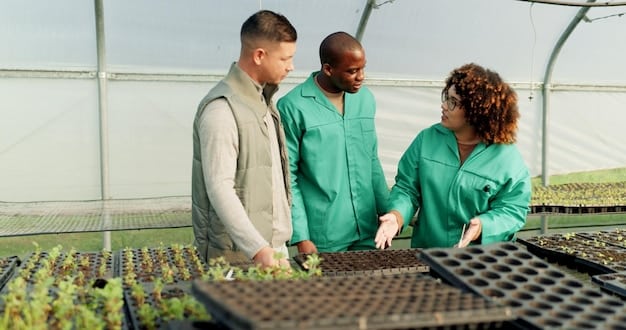
Research and Development Priorities
Continued and enhanced investment in agricultural research and development is foundational. This includes funding for climate modeling specific to agricultural regions, breeding programs for resilient crops and livestock, and studies on effective water management and pest control under changing conditions. Universities, federal research labs, and private companies must collaborate to translate scientific breakthroughs into practical, on-farm solutions.
Prioritizing research into early warning systems for extreme weather events, and developing sophisticated forecasting models, can help farmers make timely decisions to protect their assets. Moreover, social science research is needed to understand the socio-economic impacts of climate change on rural communities and to inform policies that support equitable adaptation and transition. The effectiveness of policy frameworks will ultimately hinge on their ability to integrate cutting-edge research with practical, farmer-led innovation.
Future Food Security Implications for the US
The collective impacts of climate change on US agriculture, as projected by 2040, paint a clear picture: the nation’s food security faces significant, multi-layered challenges. Food security is not merely about having enough calories; it encompasses the availability, accessibility, utilization, and stability of nutritious food for all individuals. Climate change threatens each of these pillars, necessitating concerted efforts to safeguard the nation’s ability to feed itself and its global partners.
The potential for reduced domestic agricultural output means that the US may become more reliant on food imports, introducing new vulnerabilities related to global supply chain disruptions and geopolitical factors. Simultaneously, increased food prices driven by climate impacts could exacerbate food insecurity for vulnerable populations within the US, leading to public health and social equity challenges. The pathway towards 2040 requires strategic foresight and a proactive commitment to building a resilient and equitable food system.
Domestic Food Availability and Affordability
As agricultural productivity faces constraints from extreme weather and shifting growing conditions, the sheer quantity of food produced domestically may decline or become more volatile. This directly impacts availability. Even if total food supply remains adequate, the costs associated with producing and transporting that food in a climate-challenged environment are likely to rise. This will translate into higher food prices for consumers.
For lower-income households, increased food prices can mean difficult choices between food and other necessities, potentially leading to increased rates of food insecurity and nutritional deficiencies. This raises significant public health concerns, particularly for children, the elderly, and those with chronic health conditions. Ensuring equitable access to affordable, nutritious food will become a paramount policy challenge.
Global Supply Chain Dependencies and Trade
The US is a major global food producer and exporter, contributing significantly to global food security. However, as domestic agricultural systems face climate stress, this role could diminish. Simultaneously, if other major food-producing regions around the world also grapple with their own climate impacts, the global food supply could tighten, leading to increased competition for scarce resources and higher import prices.
Increased reliance on imports to meet domestic demand could expose the US to geopolitical risks and supply chain disruptions originating in other countries. Diversifying trade partners and investing in resilient international supply chains will be crucial. Furthermore, the US agricultural export economy, a vital component of rural prosperity, could be negatively impacted if yields decline or production costs make US commodities less competitive globally.
Nutritional Security and Public Health
Beyond caloric sufficiency, nutritional security is at stake. As discussed, climate change can alter the nutritional content of staple crops, potentially reducing the availability of essential vitamins and minerals. Dietary shifts in response to price changes or limited availability of certain foods could further impact public health, contributing to diet-related diseases.
The health impacts extend to agricultural workers, who face increased risks from heat stress, exposure to new pests and diseases, and mental health challenges associated with economic precarity and extreme weather events. A holistic approach to food security by 2040 must encompass not just food production, but also its nutritional quality, equitable access, and the human health dimensions of a changing climate. The journey ahead demands a unified vision and sustained commitment to ensure a stable and nutritious food supply for all Americans.
| Key Impact | Brief Description |
|---|---|
| 🌡️ Extreme Weather | Increased droughts, heatwaves, and floods devastating crops and livestock. |
| 💧 Water Scarcity | Diminished snowpack and depleted groundwater impacting irrigation. |
| 🌾 Yield Reduction | Lower crop yields and nutritional quality due to heat and stress. |
| 🔗 Supply Chain Disruption | Infrastructure damage and market volatility leading to food price increases. |
Frequently Asked Questions About Climate Change’s Impact on US Agriculture by 2040
By 2040, US crop yields are projected to face significant challenges. Increased heat stress, more frequent droughts, and intensified rainfall can reduce productivity for staple crops like corn and wheat. While some northern regions might see longer growing seasons, the overall trend points to potential yield declines and reduced nutritional density, requiring adaptive farming practices.
Water scarcity is a major concern. Diminishing snowpack in the West and over-extraction of groundwater will exacerbate drought conditions. Increased intensity of rain events can also lead to flash floods and runoff, reducing usable water and causing soil erosion. Farmers will increasingly need highly efficient irrigation and water management strategies to cope with these challenges by 2040.
Livestock will experience increased heat stress, leading to reduced milk and egg production, slower growth rates, and higher susceptibility to disease. Changes in the availability and quality of feed due to altered growing conditions will also pose challenges. Farmers will need to invest in cooling systems and health management to maintain animal welfare and productivity.
Technology will be crucial. Precision agriculture tools, including GPS-guided machinery and sensor-based irrigation, will optimize resource use. Genetic research will develop climate-resilient crop varieties and livestock. Advanced climate modeling and forecasting will enable farmers to make more informed decisions, fostering efficiency and resilience in the face of unpredictable conditions.
Climate change is likely to lead to increased food prices and reduced affordability. Reduced domestic yields, supply chain disruptions from extreme weather, and higher production costs will drive up costs for consumers. This could exacerbate food insecurity, particularly for vulnerable populations, highlighting the need for policies that ensure equitable access to nutritious food.
Conclusion: Charting a Resilient Future for US Agriculture
By 2040, the US agricultural landscape will be visibly transformed by climate change, facing challenges from extreme weather, water scarcity, and altered biological conditions. The cumulative effect on crop and livestock productivity, coupled with inevitable supply chain disruptions, underscores the urgent need for a cohesive national strategy. While the challenges are formidable, the capacity for innovation, adaptation, and systemic resilience within the US agricultural sector remains robust. Success will hinge on continued investment in research, widespread adoption of climate-smart practices, and supportive policy frameworks that empower farmers and safeguard the nation’s food security for generations to come.

